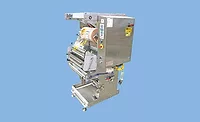Increasing Packaging Speeds

Adhesive consultants can evaluate the manufacturing process and the substrates to be spliced in order to specify the right tapes for each application.
The flexible packaging industry is the second-largest packaging segment, representing approximately 18% of the $143 billion U.S. packaging industry. Fueled by steady growth, the industry has benefited from the development of innovative products, advancements in technology, the introduction of flexible packaging into new and existing markets, and the ability to meet the ever-changing needs of customers and consumers.
Despite this growth, flexible packaging companies are increasingly feeling the pressure to reduce costs in order to remain competitive. A major driver of price can be seen in the food industry, where consumers are searching for convenience and value in the products they purchase while becoming progressively more interested in their personal impact on the environment. In response to these demands, the industry is rapidly transitioning from rigid packages to cost-effective film pouches. In addition to lowering material expense, manufacturers and converters are looking to reduce costs by addressing production efficiency as measured in product throughput as it relates to line speeds, downtime, and product waste.
Adhesives used for splicing web materials in flexible packaging and converting applications are a necessary component in the equation for efficient throughput; however, selecting the wrong adhesive for a particular machine or substrate can result in costly machine downtime and waste. Adhesive manufacturers can add significant value to products by understanding the specialized needs of this market and guiding flexible packaging manufacturers and converters in their adhesive selection process.

Splicing tapes for flexible packaging tapes are available in a variety of colors, as well as double- and single-faced and transfer adhesive constructions.
Adhesive Selection
In an industry where time is money, packaging manufacturers and converters need a product that is highly reliable, safe and easy for operators to apply. For many reasons, pressure-sensitive adhesive (PSA) tapes are an attractive bonding choice because they deliver consistent, immediate bonds with minimal preparation, require no adhesive dry times, and eliminate liquid splash to finished product. These features and benefits are proven to reduce downtime and cleanup. A PSA splicing tape used in place of a liquid adhesive allows for uniform thickness of the adhesive during application without the need for application equipment, specialized storage or the use of solvents for thinning. PSA splicing tapes also eliminate OSHA compliance issues regarding the use of liquid adhesives.Multiple factors need to be considered to ensure that the proper adhesive is selected for the application. For this reason, flexible packaging manufacturers and converters can benefit by working directly with an adhesive consultant that is well-versed in splicing tape technology and applications. Consultants can thoroughly evaluate the client’s manufacturing process and the substrates to be spliced, and provide specific training to line operators.
Four main factors should be considered when selecting a PSA for a core start or splicing application: substrates to be spliced, oven temperatures, line speeds and web tension. These factors should be evaluated through every step of production-from the beginning processes to final product conversion. Proper consideration ensures that the right splicing product (or combination of products) is used, which helps reduce or eliminate splice failure at any point in the process.
A majority of pouch-type designs are comprised of low-surface-energy polyethylene and polypropylene films that require a highly aggressive adhesive available only through rubber-based adhesives, including hot melts. Rubber-based chemistries provide high tack and peel, which is important in automatic flying splices that require adhesion levels to be established in a quarter of a second while having the bond strength to hold and immediately pull the next roll of continuously flowing product. Because rubber-based adhesives can be affected by extended exposure to temperatures over 150°F (66°C), certain chemicals and UV light, it is important to understand the entire manufacturing process to ensure the splice does not fail in downstream operations that might include these conditions.
Additional common packaging substrates include polyester and polystyrene, which are well-suited for acrylic-based adhesives. Acrylics are easily crosslinked to achieve a wide range of performance properties, making them extremely versatile for a number of splicing applications. Although they are high tack, acrylics do not bond as well to low-surface-energy or high-slip substrates. The strengths of acrylics complement the weaknesses of rubber-based chemistries, meaning they perform well in high temperatures (up to 350°F/176°C) and withstand UV light and exposure to solvents.
From an efficiency standpoint, most flexible packaging manufacturers using common substrates benefit most by using PSAs for quick-stick application. However, some specialty substrate applications may call for heat-activated or UV-curable adhesive tape technologies as an alternative splicing product.
Additional Considerations
The competitive and dynamic flexible packaging industry requires adhesive manufacturers to lead proactive interaction with their packaging clientele in order to ensure that the right products are being used for the industry’s ever-changing range of substrates and machinery upgrades. Manufacturers are investing significant capital in replacing or retrofitting production lines for additional automatic capabilities that increase throughput.Millions of dollars are often spent on new machinery, sometimes under the incorrect assumption that the tapes used on the original machinery or in other areas of the plant will successfully perform on new or upgraded equipment. Compatibility is often not the case when line speeds increase to in excess of over 1,500 ft/min. A requalification of the core start and splicing tapes, as well as splice configurations, should occur to maximize performance of any new machinery, or products on new or existing machinery.
As packaging materials continue to evolve and flexible packaging manufacturing operations become more automated, adhesive manufacturers will be challenged to offer the right mix of high-performance splicing tapes. While the majority of the PSA splicing choices for flexible packaging are based on rubber and acrylic formulations, adhesive manufacturers can tailor adhesive chemistry, adhesion levels, coat weights, carrier materials and tape constructions to offer value-added products to address a full range of splicing needs, including adhesives meeting the U.S. Food and Drug Administration’s (FDA) requirements for indirect food contact.
As production speeds increase, so does the demand for even more aggressive adhesives for challenging substrates, providing an opportunity for adhesive manufacturers to differentiate their product lines with highly visible and aggressive adhesives for high-slip materials. In this dynamic and fast-paced industry, manufacturers and converters will increasingly rely on adhesive manufacturers to help specify the right products and splice configurations. Charging forward in their mission of increasing speed and efficiency while reducing waste will help manufacturers and converters remain as competitive as possible in today’s marketplace.
For additional information, contact Adhesives Research, Inc. at 400 Seaks Run Rd., Glen Rock, PA 17327; phone (717) 235-7979; email the author at brichter@arglobal.com; or visit www.arglobal.com.
Links
Looking for a reprint of this article?
From high-res PDFs to custom plaques, order your copy today!




